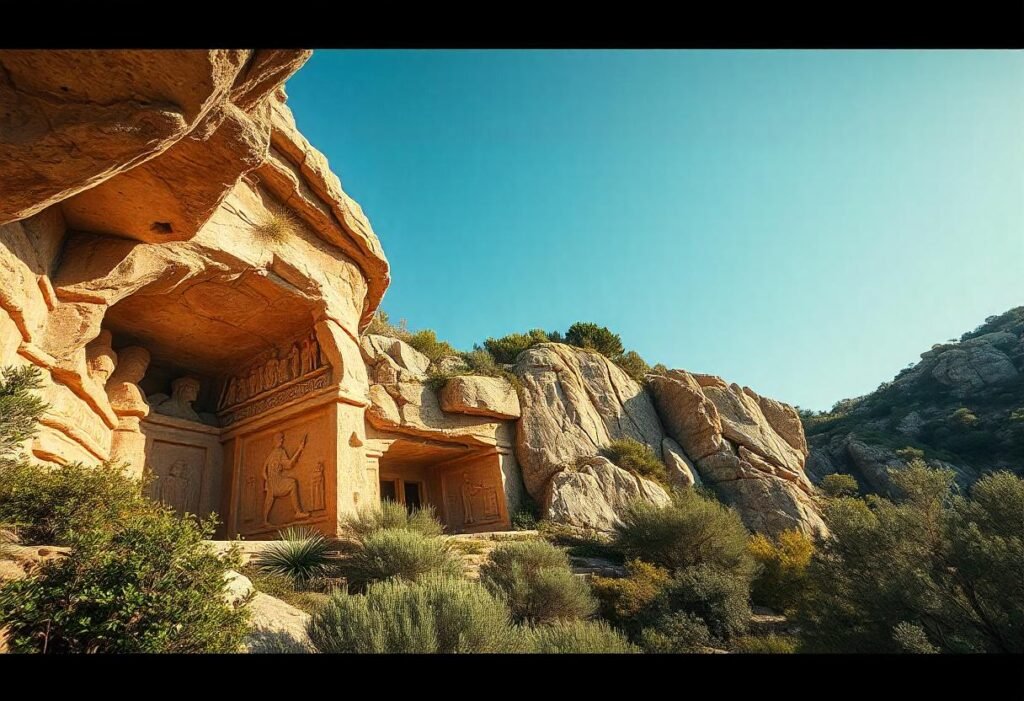Table of Contents
The Lycian Rock Tombs: A Roar of Ancient Architectural Excellence and Cultural Richness Over the Lycia Region of Turkey There are tombs carved into the cliff overlooking the Mediterranean Sea. These tombs embody more than being just a burial ground; they are works of art, representing the civilization of old Lycia. This guide shall cover the historical importance, architectural wonders, and the practical tips needed for the visitation of these great sites.
The Historical Significance of the Lycian Rock Tombs

Tracing the Origins: Who Built the Lycian Rock Tombs?
It is suggested that the ancient structures called here Lycian Rock Tombs were created by Lycians, the ancient people, who once inhabited the area in south-west Turkey about the 15th century BCE – the 4th century BCE. It is widely known that these people had a strange practice of burying their dead and architectural styles both under the influences of Hellenistic and local influences. The graves thus are the most important resting place of the dead. However, in some sense, they also represented status and power. Generally, most of them have facades that are quite elaborate-most of which are decorated with columns, pediments, and reliefs to demonstrate the importance of the deceased during their lifetime.
A Journey Through Time: The History of the Lycian Rock Tombs
According to a myth, the Lycians used to carve their tombs directly into the cliffs, while according to a historical account, Xanthus was one of those cities that owed its existence to the deeds of the Lycian people who fled there and used the house of Her263 to carve the first rock tombs in Lycia. As for the people, the Lycians were free and had a peculiar structure of government – they were the league of the cities.
The diversity of designs in the tombs is also from this aspect, as each site varies in design. Major historical events such as Roman conquests and the spread of Christianity covered the significance and preservation of these tombs. Over time, most were also reused or abandoned, but their beauty still serves to inspire today’s visitors who take time to see them.
Exploring the Lycian Rock Tombs: What to Expect
Architectural Marvels: Design and Structure of the Tombs
The Lycian Rock Tombs are an excellent example of ancient engineering and artistry. They are often found carved into sheer rock faces, making them lie in elevated sites and providing dramatic views of the surrounding landscape. Architectural styles vary from simple burial chambers to grand structures resembling temples.
These tombs boast ornate facades, many times decorated with sculptures or intricate carvings with some scenes describing the life of the deceased or mythological figures. Some of the tombs have large openings which allow family access to pay their respects; this is a blend of art and practicality, making the Lycian Rock Tombs a great subject for both the history enthusiast and the casual traveler.
Top Locations to Visit: A Guide to the Most Impressive Tombs
Not all rock tombs are alike. Only some stand out from the crowd, and these should feature in your travels to this region:
- Myra: Myra has the most extensive display of rock-cut tombs anywhere, with an almost unmatched range of facades that look like ancient temples. The site is also famous for its ancient theater, which gives you a much more complete view of Lycian culture.
- Fethiye: Carved into the rock face opposite the harbor, Fethiye’s rock tombs are of course famous for the “King’s Tomb” but all of them are accessible and given stunning views over the harbor. The carvings on the tomb also detail the life of the occupant making for a popular visitor stop.
- Kaş: This charming coastal town is again a place away from the masses. The rock tombs here are set in a lovely natural setting surrounded by olive groves and turquoise blue Mediterranean waters.
Visits to those sites make you realize the unique nature of Lycian tombs architecture as you take in the scenic goodness around.
Visiting the Lycian Rock Tombs: Practical Information
How to Get There: Transportation Options
Getting to the Lycian Rock Tombs is not so hard. Major cities the closest are Antalya and Fethiye, both good bases to explore from.
- By Air: The guests attending the area of Fethiye may use the nearest airport called Dalaman Airport located about 30 kilometers away from the area. In this case, rather than having a flight, one can contract a taxi or a shuttle in transporting him or her from the airport to the destination.
- By Bus: The bus network in Turkey is extensive. Traveling between cities is quite easy. In large numbers, there are buses between Fethiye, Kaş, and Antalya. Therefore, getting to the tombs is relatively hassle-free.
- By Car: Probably the most flexible option: you can make all the different variations in pace and stop according to preference, enjoying beautiful, winding coastal roads. An absolute must: the drive along the Lycian Way, one of Turkey’s most famous hiking trails.
Best Times to Visit: Timing Your Trip
The best time to visit Lycian Rock Tombs is during spring, when April, May, or June find the weather mild, with thin crowds of tourists. You have the delightful temperatures ideal for hiking and exploring the place without those torrid effects of summer.
Visiting the place early in the morning or late in the afternoon would have the beauty of avoiding crowds of peak tourists and would make it easier to experience some serenity among the ancient tombs.
Engaging with the Lycian Rock Tombs: Activities and Experiences
Guided Tours: Making the Most of Your Visit
While exploring the Lycian Rock Tombs individually is more than possible, the benefits of visiting them as part of an organized tour can bring additional perspectives and depth to your experience. This may be at the hands of the better-informed guides, who will guide you through interesting facts and stories about the history and meaning of the tombs themselves, or perhaps it could be the legends you would never find otherwise. Many tours will also visit other archaeological sites or nearby natural attractions, creating a much broader perspective on the rich heritage of the region as a whole.
Photography and Exploration: Capturing the Beauty
Photography enthusiasts would also recognize the beauty of the Lycian Rock Tombs. Ornate fronts to the tombs add significant contrast with the natural beauty of the landscape, making great photographs.
If time would allow, consider bringing a tripod in low-light conditions, like during sunrise or sunset when the golden lights highlight details found in tombs; otherwise, you could wildly experiment with angles and perspectives for a better fit of the grandness of the ancient structures.
Cultural Insights: Understanding the Lycian Rock Tombs
The Myths and Legends: Stories Behind the Tombs
They are also replete with myth and folklore, especially in that legend of how the Lycians believed that the spirits of the dead were seen soaring into the sky, which is why the tombs were often seen on high cliffs. Along with these legends, it not only gives a cultural context to these tombs but also enhances that mystical aura surrounding them.
Exploring the myths of the Lycian civilization may make your visit even more fascinating and rich as you further appreciate the tombs themselves and the people who constructed these masterpieces. The local guides are usually rich in myths and make the tour even more interesting.
Respecting the Heritage: Etiquette When Visiting
As an accountable tourist, you should respect the cultural heritage of the Lycian Rock Tombs. Here are some dos and don’ts:
- Do Not Touch the Artwork: The carvings and buildings are delicate and can never be replaced; it is best not to touch or climb on tombs.
- Stay on Designated Paths: For the protection of the site and for your own safety, stay on marked trails and paths.
- Be Mindful of Noise: Be quiet silent in any place, specifically on the sacred areas so that others can have fun in this very peaceful environment.
By using these simple tips you will be contributing to the preservation of beauty and integrity of the Lycian Rock Tombs for future generations.
Check Out:
Nearby Attractions: Extending Your Journey

Other Historical Sites and Natural Wonders
If you are planning to visit the Lycian Rock Tombs, go on a tour to the other attractions that lie nearby in order to enjoy the experience during your visit.
- Patara Beach: one of its great beauties is the sand which is incredibly soft and the waters are very pure. A perfect place for sun tanning, swimming or just relaxing after a day of enjoying Peter’s creations.
- Xanthos: This ancient city in the Lycian region of Turkey now is the UNESCO World Heritage site, which has numerous and impressive ruins including a theater and sacred shrines.
- Butterfly Valley: Reached by boat from Ölüdeniz, this cute gorge is home to a couple of species of butterflies as well as simply wonderful views of the sea and cliffs.
Local Cuisine: Tasting Lycian Flavors
What trip to Lycia would be complete without trying what this local region has on the menu? Here you can find Iskender kebab, sea animals and Mediterranean dishes along with delicious Turkish specialties. Here are some of the things that you would want to try when visiting.
- Pide: Also known as Turkish pizza, this bread looks almost like a boat and is often topped with numerous ingredients including cheese, veggies, and meats.
- Meze: A collection of appetizers, meze consists of goodies such as hummus, stuffed grape leaves, or olives-an excellent choice when sharing with others.
- Seafood: Since Turkey is bordering the Mediterranean, fresh fish and seafood are common. Try some grilled fish or shrimp, fried with local herbs and spices.
To truly indulge in the best of culinary dishes, seek out local bistro restaurants or street markets that emphasize authentic preparation and seasonal ingredients.
Conclusion: Embracing the Legacy of the Lycian Rock Tombs
Preserving the Heritage of Lycian Rock Tombs Lycian Rock Tombs are more than history; they are a glimpse of yesteryear’s glories, as to what the great people of ancient Lycian culture enjoyed, lived, and prospered in. This architecture combined with breathtaking features of the natural surroundings, is sure to make a must-visit destination for those seeking adventure and traveling to be culturally enriched. Spend some time during your visit to these magnificent tombs delving into their history, listening to the stories they tell, and showing respect to the legacy of people who came up with such wonders.
Whether you are a history, architecture, or any other travel experience enthusiast being unobtrusively unique, Lycian Rock Tombs will prove to be an unforgettable experience for you. Visit, explore, and engage with this deep cultural heritage to make memories that last even when your journey is over.
For more info : Click Here.
FAQs About the Lycian Rock Tombs
What are the Lycian Rock Tombs, and where are they located?
The Lycian Rock-Tombs are tombs carved in the face of a large rough rock face in the southwest region of modern Turkey and many are in the Lycian region. They are renowned for their magnificent architectural design and history, which helps people get an idea of the ways of burial of bodies by the people of the ancient civilization of Lycia.
Are the Lycian Rock Tombs accessible to tourists?
Yes, the Lycian Rock Tombs are generally visitor-friendly. Many tombs sit near the popular towns of Fethiye and Kaş; you will find marked paths and viewing areas. Of course, still, keep in mind some of the locations have restricted accessibility, especially those along steep cliff faces.
Can I explore the Lycian Rock Tombs independently, or should I join a tour?
While the Lycian Rock Tombs are accessible and visitable independently, a guided tour could be helpful in increasing the understanding of locations. History and interesting stories about the tombs can be explained by an accomplished guide, which will add variety to the said tombs.



